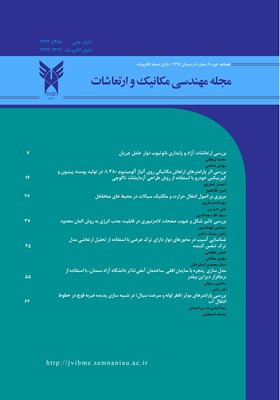بررسی تجربی ریز ساختار آلیاژ آلومینیوم درفرآیندECAP و مقایسه دو مقطع گرد و مربعی
محورهای موضوعی : انتقال ارتعاشات
1 - گروه مکانیک ، دانشکده فنی مهندسی ، دانشگاه آزاد اسلامی ، واحد سمنان ، سمنان، ایران
کلید واژه: ریزساختار, پرس زاویه ای ECAP, آلیاژ آلومینیوم 6xxx, کارسختی,
چکیده مقاله :
پرس کردن مواد در قالب های زاویه ای ECAP یکی از روش های شکل دهی است که به منظور ایجاد کرنش های بالا جهت کارسختی و بهبود ریز ساختار انجام می گردد و با استفاده از شکل دهی تحت فشار و تحت زاویه در قالب و در اثر پدیده کارسختی ایجاد شده ، بهبود ریزساختار ، خواص مکانیکی خوب و قابلیت انعطاف پذیری بالا حاصل می گردد. در این مقاله کیفیت تغییر ریز ساختار و بهبود شرایط و مقاومت مکانیکی با استفاده از روش پرس کردن برای آلیاژ آلومینیوم ( 6xxx ) در قالب زاویه ای بررسی شده است به نحوی که قالب تهیه شده دارای دو مقطع مربعی و دایره ای بوده و نمونه ها فقط یک بار پرس شدند و همچنین تفاوت های حاصل از این دو مقطع ، در تغییرات ریز ساختار بررسی شده است. نتایج حاصل از بررسی ها نشان داد که با پرس کردن نمونه ها بهبود و یکنواخت شدن ساختار حاصل گردید و در این میان نمونه های با مقطع دایره ای شرایط بهتری از آثار کار سختی و بهبود ساختار را نشان داد.
Pressing materials in ECAP angular molds is one of the forming methods and processes that is done in order to create high strains and stiffness with microstructural improvement. Using angle forming in molds with high pressure, and due to the certation of work hardening phenomena, microstructural improvement, good mechanical properties and high flexibility can be achieved. In this paper, the quality of microstructure changes and the improvement of conditions and mechanical strength using the pressing method for aluminum alloy (6xxx) in an angular form is investigated. In this way the prepared forms have two square and circular cross sections and the samples were pressed through the angular pass only one time. The results of the studies showed that by pressing the samples, the structure was improved and uniform microstructure achieved. In the meantime, the samples with a circular cross-section showed better conditions of the effects of work hardening and structural improvement.
_||_


